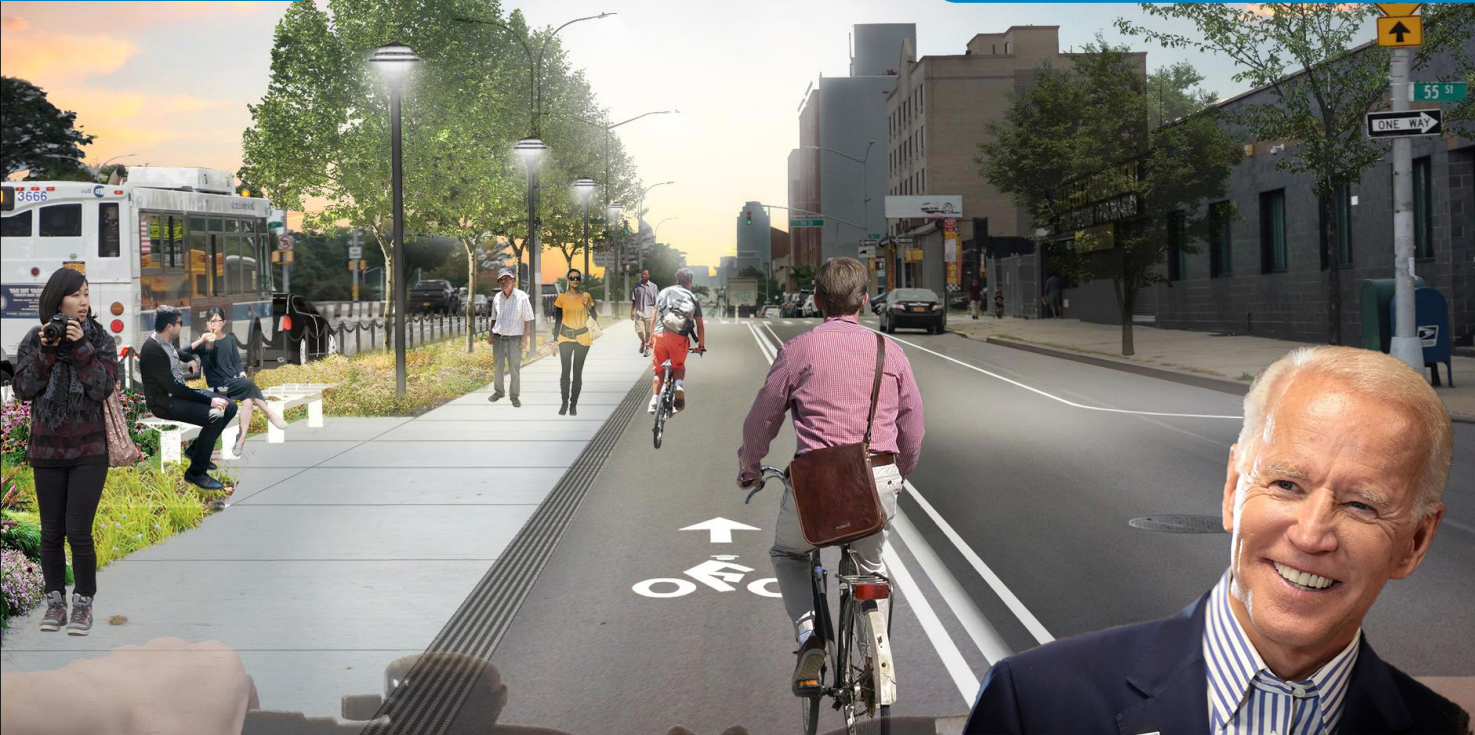One of New York City's biggest projects is now also one of the Biden Administration's biggest.
The redesign of Queens Boulevard — an epic, decade-long struggle to add a bike lane to a roadway once known as the Boulevard of Death — was the top recipient this week of federal Safe Streets and Roads for All grants, nabbing $29.75 million from a pot of close to $890 million spent on 620 projects nationwide [map].
The money will partly fund "Implementation of Queens Boulevard Great Streets Transformation and Supplemental Planning for Vision Zero," according to the federal Department of Transportation. The overall, four-phase project has a budget of $250 million.
The feds said the money would be used to bolster "low-cost quick-build solutions already implemented to address safety issues resulting from being a vehicle-centric corridor, with limited crossing opportunities and facilities for vulnerable users, and higher vehicle speeds."
"The [grant] also includes supplemental planning to enhance surveillance on traffic-related fatalities and injuries not routinely available in police crash reports," the US DOT continued. "In addition, DOT will retrofit a portion of fleet vehicles with active and centrally managed Intelligent Speed Assist to prevent speeding as a demonstration activity," the feds said, suggesting that the funding is a bit of a Vision Zero grab bag.
The New York City Department of Transportation did not respond to questions about the happy news. But other Safe Streets and Roads for All grant recipients have been very quick to put out statements touting the federal cash infusion.
Sen. Chuck Schumer (D-New York) touted the $17.9 million in grants to multiple projects across the rest of New York State.
"From new improved bike and bus lanes to safer intersections and sidewalks, this over $17.9 million investment from our Bipartisan Infrastructure & Jobs law will help give communities from Rochester to Albany the tools they need to develop plans for safer streets while creating jobs," he said in a statement.
California localities got roughly $139 million, prompting a similar infusion of joy from the state's junior senator Alex Padilla.
"Far too often, we hear stories of children injured on their way to school, cyclists blindsided at major intersections, and deadly vehicle crashes during the daily commute," he said in a statement. The action plans developed and implemented in California communities with this funding will curtail collisions and save lives.”
That much is true for the biggest grant recipient.
Between 2016 and 2020, 233 people were injured on the 1.2-mile portion of Queens Boulevard between Union Turnpike and Hillside Avenue, the last phase of the project, according to the DOT.
The benefits of the safety redesign are clear: According to the city DOT, pedestrian injuries decreased by 41 percent on the stretches that have been redesigned and total injuries decreased by 22 percent.
After Queens Boulevard, the top 15 recipients of federal Safe Streets for All money were:
- Fayetteville (Ark.): implement its Vision Zero strategy to fix roadways that were constructed using outdated auto-oriented designs that invite high-speed driving and lack basic infrastructure for non-vehicular use. ($25 million)
- Phoenix: intersection and pedestrian infrastructure changes and safety treatments along Indian School Road between 91st and 39th Avenues ($25 million)
- Dearborn: A road diet that focuses on a dual lane reduction on Warren Avenue. ($25 million)
- Detroit: improve safety and bus stop accessibility at 56 high-crash intersections. Improvements will support safer transfers between different routes and active/shared modes. ($25 million)
- Boulder: focus on three key problems: pedestrian safety at marked, non-signalized crosswalks, crashes affecting vulnerable road users on priority arterial segments, and severe-injury crashes at six key intersections. ($23 million)
- Dallas: multiple improvements on Martin Luther King Jr. Boulevard/Cedar Crest Boulevard for pedestrians and bicyclists. ($22 million)
- Lexington-Fayette Urban County Gov't: reconstruct a portion of New Circle Road to implement significant safety upgrades on the highest fatal and serious-injury corridor identified in the Lexington Safety Action Plan. ($22 million)
- Chicago: implement corridor safety improvements on Ogden Avenue in North Lawndale. ($21 million)
- Minneapolis: implement its Vision Zero Action Plan and target the highest-priority projects in the city’s Vision Zero Action Plan. ($20 million)
- Fontana (Calif.): dramatically improve safety for motorists, pedestrians, and bicyclists with complete infrastructure improvements along Foothill Boulevard (part of historic Route 66). ($20 million)
- Lancaster (Calif.): multiple Complete Streets improvements on Challenger Way, which had a total of 148 crashes, including nine killed or severely injured, between 2017 and 2021. ($19.6 million)
- Philadelphia: implement systemic and corridor-specific safety countermeasures in underserved areas. ($16.4 million)
- Miami-Dade: infrastructure improvements at 24 locations on the county's high-injury network along its high-speed arterial and collector roads. ($16.2 million)
- Salinas (Calif.): implementing multiple safety improvements on Williams Road. ($16 million)
- Virginia Beach: multiple safety improvements for the Virginia Beach Trail, a shared-use path that will create more than three miles of pedestrian and bicycle trails completely separated from vehicles. ($14 million)
“Every year, crashes cost tens of thousands of American lives and hundreds of billions of dollars to our economy; we face a national emergency on our roadways, and it demands urgent action,” Transportation Secretary Pete Buttigieg said when the grants were announced. “We are proud that these grants will directly support hundreds of communities as they prepare steps that are proven to make roadways safer and save lives.”





